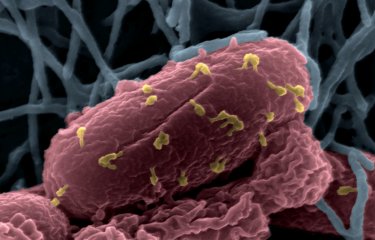Scientists from the Institut Pasteur have developed a method for increasing the spatio-temporal resolution in optical microscopy. This method, called ANNA-PALM, is based on recent developments in artificial intelligence and, more specifically, in much-talked-about deep learning. This article explores the method.
"Traditional optical microscopes can be used to distinguish structures in the range of 200 to 300 nm but not smaller. Tinier objects are seen as specks of light under the microscope and their internal structure is not visible. This is the case, for example, with the conical-shaped AIDS virus capsid, or octagonal nuclear pores. In both cases, we can only see blurred spots with a traditional microscope", explains Christophe Zimmer, head of the Imaging and Modeling Unit at the Institut Pasteur. To overcome this resolution issue, "super-resolution" microscopy methods were developed, such as the PALM and STORM techniques, which appeared in 2006 and are based on single-molecule localization. These methods can resolve structures down to the 20 nm range but are extremely slow. "The speed of super-resolution microscopy methods based on single-molecule localization is limited, because several thousand low-resolution images need to be recorded, each of which showing only a small number of molecules". In practice, this makes it difficult to use high-resolution imaging for more than a dozen cells or to observe dynamic structures in living cells.
To speed up super-resolution microscopy, scientists from the Institut Pasteur have developed a new method called ANNA-PALM. This technique uses artificial neural networks (see Christophe Zimmer interview) to reconstruct super-resolution images from rapidly acquired low-resolution images. "Our simulations and experiments on microtubules, nuclear pores and mitochondria show that super-resolution images can be reconstructed from data acquired in significantly shorter time, and without compromising spatial resolution", continues the scientist.
Under the right conditions, ANNA-PALM can speed up super-resolution microscopy by a factor of 10 to 100. Thanks to this increase in speed, "ANNA-PALM can be used to obtain super-resolution images of thousands of cells in a few hours, which used to be practically impossible." A film demonstrating this, and providing the software tools developed, can be seen here: annapalm.pasteur.fr.
Thanks to the drastic reduction in acquisition time and laser irradiation, ANNA-PALM should greatly facilitate super-resolution imaging of living cells. This method also opens up other possibilities, for instance high-throughput screening of chemical molecules for therapeutic purposes.
NB : The Institut Pasteur provides computing resources including GPUs (Graphics Processing Units) that allowed the team of Christophe Zimmer to carry out this study. The Inception program funded a GPU Farm, used by the authors for this work, and the project also benefited from GPUs made available by the Information Systems Department (DSI) of Institut Pasteur.
Source
Deep learning massively accelerates super-resolution localization microscopy, Nature biotechnology, April 27, 2018
Wei Ouyang1–3, Andrey Aristov1–3, Mickaël Lelek1–3, Xian Hao1–3 & Christophe Zimmer1–3
1. Institut Pasteur, Unité Imagerie et Modélisation, Paris, France.
2. UMR 3691, CNRS, Paris, France.
3. C3BI, USR 3756, IP CNRS, Paris, France.

Artificial intelligence: deep learning is blazing ahead





